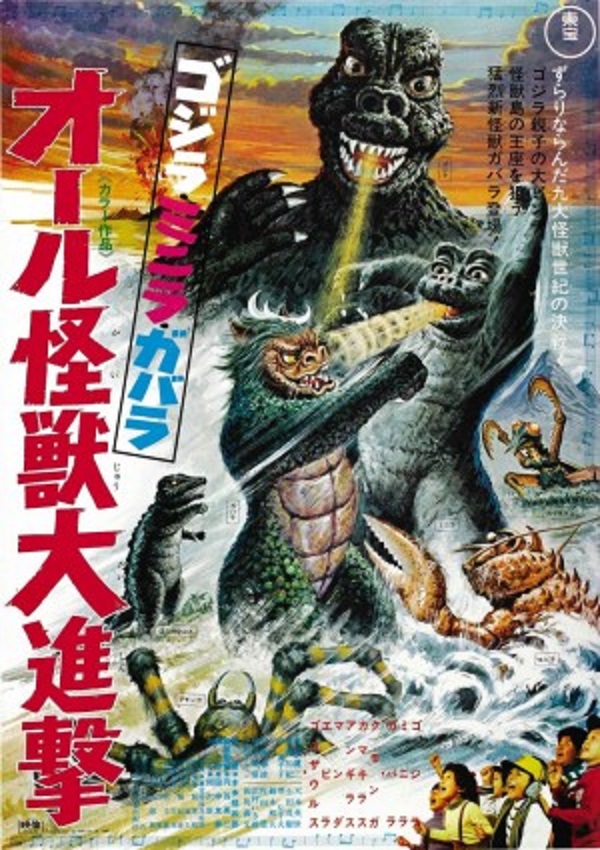Previous FilmAlien Species
Next FilmAlligator
All Monsters Attack 1969
 | A bullied schoolboy dreams of traveling to Monster Island, where he befriends Godzilla's son, who is also having bully troubles. |
The Cast
| Tomonori Yazaki | - | Ichirô Miki |
| Hideyo Amamoto | - | Shinpei Inami |
| Sachio Sakai | - | Bank Robber Senbayashi |
| Kazuo Suzuki | - | Bank Robber Okuda |
| Kenji Sahara | - | Kenkichi 'Tack' Miki (Ichiro's Father) |
| Machiko Naka | - | Ichirô no okâsan |
| Shigeki Ishida | - | The Landlord |
| Midori Uchiyama | - | Minira |
Film Trivia
This was deliberately set out be a Godzilla film aimed at small children for release during the Christmas season. Among the more unusual aspects of the film was the casting of Hideyo Amamoto as a toy designer and friend to the little boy. Amamoto was normally cast in other films as the slimiest of criminals, gangsters and henchmen.
Much of the imaginary scenes taking place on Monster Island are made up of stock footage taken from various other Godzilla films. However, the scene when Godzilla tries to teach his son how to fire nuclear breath was newly shot instead of being a reuse of an identical scene from Kaijûtô no kessen: Gojira no musuko (1967).
Director Ishirô Honda intended the movie to have a somber ending, but had to add a more cheerful final sequence in which Ichiro goes to play with his friends. When the movie was re-released on home video during the 80s, Honda removed this scene, so the movie ends with Ichiro's mother crying due to not being able to spend more time with her son.
The movie was inspired by Gamera movies such as Gamera tai uchu kaijû Bairasu (1968), which made use of stock-footage shamelessly copied from earlier Gamera entries. Since the Godzilla movie series was performing progressively worse, producer Tomoyuki Tanaka looked at the Gamera films, cheap rip-offs of his once prestigious Godzilla franchise that was still popular among small kids, for inspiration on how to create a Godzilla movie with reduced costs. Thus, he asked scriptwriter Shin'ichi Sekizawa to write a movie based around preexisting Godzilla footage and imitate their own imitator.
Eiji Tsuburaya was so busy with his company, Tsuburaya Productions, during the production of this film that Ishirô Honda had to take over the effects direction, which resulted in limited special effects work and stock footage. Tsuburaya did not work on the film at all, aside from the stock footage, but is credited out of respect.
The "Monster March" theme song from the Japanese version is composed by Genta Kano, best known for composing the theme song to the Japanese classic, Tôkyô nagaremono (1966).
After years of playing mainly villains, this was the first time Hideyo Amamoto was asked to play a somewhat fatherly figure in the person of toymaker Shinpei. However, he was not particularly fond of this role.
Since all of the monsters appear only in Ichiro's imagination, it is never made clear whether they exist in the movie's real life universe or if they only appear in the dreams of Ichiro.
This was Yoshifumi Tajima's final appearance in a Showa Era film. His next, and final, series appearance was in the first film of the second Godzilla series, Gojira (1984).
The head of the monster Gabara was created by tweaking the head design of a previous Godzilla suit.
Often considered the worst Godzilla movie by fans for its childish plot, an annoying child protagonist, its focus on the unpopular monster Minilla who even talks this time, its heavy use of stock-footage from earlier films, and for forwarding a controversial message.
This was the final appearance of the Gorosaurus. Manda, Kamacuras, Kumonga and Minya would not be seen again until Gojira: Fainaru uôzu (2004).
Despite using copious amounts of stock footage from earlier films, the scene in which Godzilla tries to teach his son how to breathe atomic flame was newly shot. Director Ishirô Honda wanted to avoid simply reusing a very similar sequence from Kaijûtô no kessen: Gojira no musuko (1967), and instead put his own spin on the scene by making Godzilla be more strict with his son this time around. This was part of the movie's theme of paternal neglect and children having to stand up for themselves.
Decades after the film's release, actor Kenji Sahara couldn't remember appearing in it, only that he was allowed to drive a train engine during shooting.
According to the production notes, the monster Gabara is supposed to be a mutated toad, hence why he lacks a tail. His name has had a couple disputed origins: some believe it's a dig at Argentine revolutionist Che Guevara, others say it was based on the German word "Gewalt", meaning "violence".